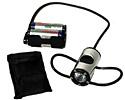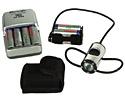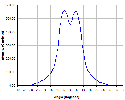
Recently on Cyclingnews.com |
On test: Dinotte Ultra 5 road headlight, August 29, 2006
Best and fairest
Steve Beletich finds that extreme brightness, low weight and exceptional battery life combine to produce what is quite possibly the ultimate road bike headlight.

|
Dinotte's aim with this compact, high-power LED light was to make a class-leading headlight for road bike use. While mountain bikers require large amounts of illumination that still seem to be best provided by HID and halogen systems, your typical road rider is more concerned about being highly visible to oncoming motorists, while having a moderate amount of illumination to show up potholes and other imperfections in the road. Oh, and compact dimensions and light weight also rate a mention for the style gurus and weight weenies among us.
In answer to that brief, Dinotte has chosen the 3 and 5 Watt Luxeon LEDs that have a coveted best-of-breed reputation in lighting circles. In our Ultra 5 model, a 5 Watt Luxeon is powered by four rechargeable double-A NiMH cells (each with a staggering 2300 mAh charge capacity). These sit in a pouch just under the handlebar stem or top tube. The whole shebang weighs just 200g and will blind you for several minutes if you're foolish enough to look straight at the beam. Dinotte claims a run time of three hours in low power mode and 100 minutes in high.
The headlight unit consists of a 55mm long x 28mm diameter drilled aluminium barrel, which is secured by a large rubber strap to the top of the handlebars. The bottom of the barrel is scalloped so that it sits snugly on top of the bars, and there's a simple power switch and operation light at the rear.
|
|
|
|
|
The battery pack contains four AA batteries, each of 1.2 volts and 2300 mAh (milli-amp-hours) capacity. This means that the combined battery pack of four batteries can produce 4.8 volts and 2.3 amps of current for one hour. Or, in power terms, it is capable of providing 11 watts (4.8 volts x 2.3 amps) for one hour, or if you like 3 watts for 3.6 hours.
We sent the Ultralight to be tested at Sylvania's accredited light laboratory just north of Sydney (www.sla.net.au). A special thanks goes to Sebastian Beier in the lab for assessing the Ultralight and performing some complex calculations. Sebastian tested the unit on a goniophotometer, which is a fancy word for a machine which measures light intensity at various beam angles. The figure below illustrates the results of this test.
From this figure it can be seen that the Ultralight puts out a maximum luminous Intensity of around 560 Candelas, at around 5 degrees from the central beam. It has an effective beam angle of around 10 degrees, which is the point at which intensity drops to 50 pecent of maximum.
Beier performed some very complex calculations to convert all the intensity readings to total light output for the Ultralight. He found that it emitted 156 lumens, whilst drawing 2.94 watts from the power supply. This means that the unit has a net efficiency (efficacy) of 53 lumens per watt. By comparison a typical 10 watt halogen lamp, without reflector and lens, has an efficiency of only 14 lumens per watt. This will reduce to at least 10, once the inefficiency of the reflector and lens are taken into account. Thus the Ultralight is five times more efficient than an average halogen headlight, under ideal conditions.
All this theory translated well into practice, with the Ultralight providing a searing beam which was sufficient to light up the road's potholes, and most importantly to make me very visible to oncoming traffic. This I know because I received several comments from fellow cyclists about just how visible I was for several hundred meters when approaching the bunch. Most impressive was the Ultralight's ability to illuminate reflective road signs and road markers, which glowed hundreds of meters in the distance.
Low power mode and high power mode were almost indistinguishable from each other, and in low power mode the batteries gave a solid three hours of light as promised. After this the unit dropped into a very low power mode and ultimately reverted to a safety mode which lasted 18 hours before I got sick of checking it and unplugged the battery. This kind of performance, combined with light weight, sexy design and a sensible attaching system for light and battery pack, made it very difficult to fault the Dinotte Ultralight. Thus I have no choice but to bestow upon it the coveted, stays-crunchy-in-milk rating of 5 from 5.
Retail price: US$199.00
Weight: 200g
Pros: Brightness, battery life, weight, compact dimensions
Cons: None
More information: www.dinottelighting.com
; UK importer: www.on-one.co.uk
Cyclingnews Rating: ![]()




